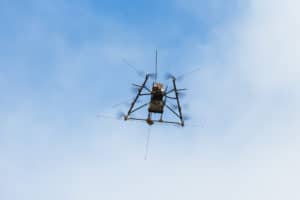Share this article
Drones help researchers survey small parrots
For over 20 years, the movements of the critically endangered swift parrot (Lathamus discolor) have largely remained a mystery given the small size and highly variable annual movements of these migratory birds.
“In the past, researchers have attempted to manually track swift parrots by attaching VHF radio transmitters to the birds, since GPS and satellite tags that provide data remotely are too large for this small migratory bird,” said Debbie Saunders, a conservation ecologist with Australia National University and founder of the company Wildlife Drones. “They then had to walk around for hours and days on end holding up a heavy antenna in the air in an attempt to pick up their signals.”

Lightweight, flying robots can help track hard to track species such as the swift parrot. ©ANU Media
But it was very time consuming and labor intensive to find even one swift parrot using this technique, she said, since the birds can move over large distances very quickly. Researchers were constantly searching for high ground to increase their chances of picking up a “ping” from a distant radio tag.
“We needed to find a better way to efficiently find tagged animals across broad landscapes so that we could better understand their movements and protect the animals and their habitat,” Saunders said.
To tackle the problem, Saunders and colleagues from the University of Sydney developed a robotic radio-tracking drone system, using drones as a high point that could locate the signals from radio-tagged wildlife. They recently published a study in Science Robotics demonstrating how this system can find and locate radio-tagged swift parrots in tall forest.
In the study, Saunders and her colleagues compared the technique to manual radio tagging and found the robotic drone could track the tagged birds at least as fast as someone manually tracking in an environment that was easy to walk around in. In locations where the terrain is rugged or has limited access, the benefits could be much greater, she said.
“I think it’s really exciting to be working on cutting-edge technology that can improve our understanding of even the most cryptic animal movements and provide a sound basis for improving conservation and land management practices,” Saunders said.
Header Image: Critically endangered swift parrots are hard to track, but drones can help, researchers found. ©Brett Allan








